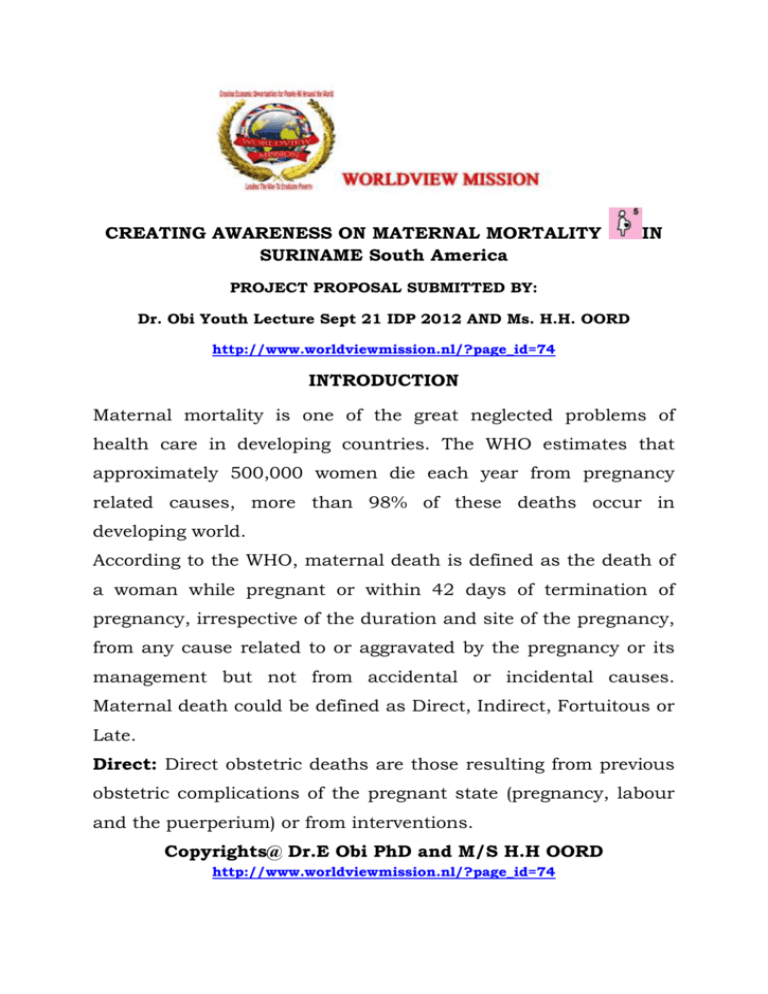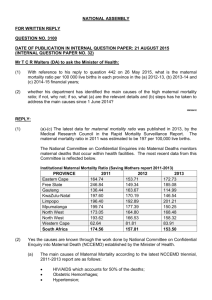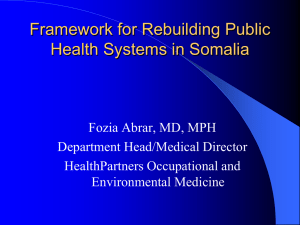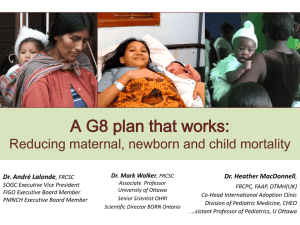CREATING AWARENESS ON MATERNAL MORTALITY IN
advertisement

CREATING AWARENESS ON MATERNAL MORTALITY SURINAME South America IN PROJECT PROPOSAL SUBMITTED BY: Dr. Obi Youth Lecture Sept 21 IDP 2012 AND Ms. H.H. OORD http://www.worldviewmission.nl/?page_id=74 INTRODUCTION Maternal mortality is one of the great neglected problems of health care in developing countries. The WHO estimates that approximately 500,000 women die each year from pregnancy related causes, more than 98% of these deaths occur in developing world. According to the WHO, maternal death is defined as the death of a woman while pregnant or within 42 days of termination of pregnancy, irrespective of the duration and site of the pregnancy, from any cause related to or aggravated by the pregnancy or its management but not from accidental or incidental causes. Maternal death could be defined as Direct, Indirect, Fortuitous or Late. Direct: Direct obstetric deaths are those resulting from previous obstetric complications of the pregnant state (pregnancy, labour and the puerperium) or from interventions. Copyrights@ Dr.E Obi PhD and M/S H.H OORD http://www.worldviewmission.nl/?page_id=74 Indirect: Indirect obstetric deaths are those resulting from previous existing disease or disease that developed during pregnancy but was aggravated by the physiological effects of pregnancy. Fortuitous: These are deaths that occur from unrelated causes that happen to occur in pregnancy or the puerperium. Late: These are deaths that occur after 42 days and within one year following a miscarriage or delivery, that are due to direct or indirect causes. INCIDENCE Everyday, 800 women die from pregnancy-related causes during pregnancy, childbirth and post-partum. Over 99% of these 287,000 annual deaths occur in developing countries and most are avoidable. About 56% of the deaths occurred in sub-Saharan Africa with another 29% in south Asia. These two regions together account for 85% of maternal mortality in the world. Absolute number of maternal deaths by regions (2010) Sub-Saharan Africa - 162,000 South Asia 33,000 - Copyrights@ Dr.E Obi PhD and M/S H.H OORD http://www.worldviewmission.nl/?page_id=74 East Asia and Pacific - 23,000 Latin America and Caribbean - 5,800 Middle East and North Africa - 5,200 Europe and central Asia - 1,900 High income earners - 1,700 180,000 160,000 140,000 120,000 100,000 80,000 60,000 40,000 20,000 0 Sub-Saharan Africa South Asia East Asia and Latin America Pacific and Caribean Middle East and North Africa Europe and Central Asia AETIOLOGY/CAUSES The causes of maternal mortality are broadly similar in developed and developing countries but the ranking is different. The five top ranking causes of maternal deaths shown in the table below are similar for most of the tropical and developing countries while in developed countries the top three include Copyrights@ Dr.E Obi PhD and M/S H.H OORD http://www.worldviewmission.nl/?page_id=74 thrombosis and thromboembolism, hypertensive disease, and amniotic fluid embolism. S/N Percentage (%) 1. Haemorrhage 25% 2. Sepsis 15% 3. Toxaemia 12% 4. Unsafe abortion 13% 5. Obstructed labour 8% 6. Other direct causes 7% 7. Anaemia, Hepatitis, 20% Malaria,Tuberculosis ect Source: WHO/AFRO/DRH/2002 30% 25% 20% 15% 10% 5% 0% Copyrights@ Dr.E Obi PhD and M/S H.H OORD http://www.worldviewmission.nl/?page_id=74 1. Haemorrhage Obstetric haemorrhage occurs in the form of antepartum and postapartum haemorrhage. Antepartum haemorrhage usually occurs mainly from placenta praevia and abruption placentae. Obstetric haemorrage is the principal cause of maternal death in developing countries but is now a rare cause of death in develop countries. In developing countries, efficient blood transfusion services are lacking. The king of patients that will need blood donation are invariably accompanied by relations that are not ift for blood transfusion. There are very few or no volunteer donors and the HIV/AIDS pandemic has reduced the number of commercial donors. http://www.youtube.com/watch?v=GzfF-uF7hQM 2. Sepsis Puerperal sepsis remains an important cause of maternal death in the developing countries partly because of non-availability of wide choice of antibiotics and the prohibitive cost of the effective newer generations. Also worthy of note is the fact that more women deliver in their homes under hygienic conditions than in the health institutions. Copyrights@ Dr.E Obi PhD and M/S H.H OORD http://www.worldviewmission.nl/?page_id=74 3. Toxaemia Teenage pregnancies and lack of antenatal care act in concert to make eclampsia a major cause of maternal deaths in developing countries. In this country, there is a tendency to refuse hospital admission at the pre-eclamptic stages because of absence of symptoms. Some are admitted after several fits that fail to respond to traditional measures. In some centres in the developing countries, eclampsia is the most common cause of death amongst primigravidae. Death from hypertensive disease in pregnancy still occurs in the developed countries largely due to sub-standard care. 4. Unsafe abortion Illegal or criminally induced abortion is a significant cause of maternal mortality especially in countries with restrictive abortion laws like Nigeria. In these countries, abortion is performed under cover by quacks in less than satisfactory conditions with all the attendant complications including death. Copyrights@ Dr.E Obi PhD and M/S H.H OORD http://www.worldviewmission.nl/?page_id=74 5. Obstructed labour Ruptured uterus following labour is an important cause of maternal deaths in developing countries. Obstructed labour is common in the tropics and so also is high parity and unsupervised deliveries. The decision to have hospital care whenever there is dystocia often comes late and the poor transportation system compounds the problem. Mortality becomes inevitable when we add the fact that services are not completely free even for such patients in public hospitals. 6. Anaemia in pregnancy Inadequate food intake both in quality and quantity has made anaemia a common cause of maternal mortality in the tropics. Incidentally, it is also the area where haemoglobinopathies flourish. Most deaths occur when cardiac failure results from severe anaemia. 7. Ectopic pregnancy It is becoming an important cause of maternal mortality in developing countries, since the incidence is said to be rising following increase in pelvic inflammatory disease. Deaths result from ruptured cases where surgery is delayed because of wrong Copyrights@ Dr.E Obi PhD and M/S H.H OORD http://www.worldviewmission.nl/?page_id=74 or lalate diagnosis. It is one condition in which the operation shold not late diagnosis. It is one condition in which the operation should not await resuscitative measures; these should proceed while the operation is being performed. 8. Medical disorders of pregnancy Hepatitis, renal disease, cardiac diseases, seasonal diseases like meningitis are important medical disorders that could cause maternal deaths in the tropics. Malaria and HIV/AIDS are also important causes of maternal deaths in developing countries. 9. Anaesthesia In developing countries, where patients report late in labour with a full stomach, vomiting induced by general anaesthesia followed by Mendelson’s syndrome could be an important cause of maternal death. In developed countries, greater use of epidural rather than general anaesthesia, use of trained anaesthesiologists and ready availability of intensive care facilities have improved the safety of obstetric anaesthesia and reduced deaths associated with anesthesia. Copyrights@ Dr.E Obi PhD and M/S H.H OORD http://www.worldviewmission.nl/?page_id=74 10. Pulmonary embolism This is still the most common cause of maternal mortality in the developed countries of the world. The overall contribution as a causes of maternal mortality in developing countries is however low. If autopsies were performed more frequently perhaps more cases would be documented. Prevention/Reduction of maternal mortality 1. Universal formal education For the girl child, this will increase the age at which she will have her baby since she is likely to avoid pregnancy during the period of schooling. It will also increase her awareness and utilization of maternity services. With increased social and economic status which education might bring to her, she is more likely to have improved nutrition and afford medical care. The male child that is exposed to formal education is more likely to support his spouse later in life. More importantly is the ability to free oneself from some of the cultural or traditional practices that are incompatible with good health. 2. Provision of social services Maternal health is intricately linked with availability of basic social amenities. Good roads, improved transportation system, and communication services will all improve the utilization of obstetric services. The woman can easily reach health facilities at the time of need. 3. Development of maternity services There has been a belated recognition that the public health approach that has successful in lowering the infant mortality rate in developing countries (immunization, growth monitoring, nutritional supplementation etc) is inappropriate for tackling the high rates of maternal mortality. There is need to have well equipped health facilities where life-saving obstetric procedures like caesarean section for obstructed labour and removal of retained placenta can be performed. In 2006, nearly 61% of women gave birth with the help of a midwife or doctor, compared to 55% in 2004 http://www.mdgmonitor.org/map.cfm?goal=4&indicator=0&cd= Copyrights@ Dr.E Obi PhD and M/S H.H OORD http://www.worldviewmission.nl/?page_id=74 4. Manpower provision Health facilities should be manned by adequate and well-trained practitioners. The staff should be equally well remunerated. There is also inequality in the distribution of health workers in most developing countries. The imbalance is such that the rural areas where their services are needed most have little or none while the urban centres are relatively overloaded. There should be extrapackages or incentives for those that work in the rural areas, if we must reverse the trend. 5. Review of abortion laws We have a choice to either confront the realities of our situation by reforming the laws so that patients may have access to safe abortion by trained personnel or deny the truth and keep quacks in business. Where the latter is chosen, we should be prepared to provide good quality services to treat the complications. 6. Family Planning services Family planning services which will encourage spacing ofchildren and reduce high parity should be integrated into maternal and child health programmes. These services must be affordable and easily available. Copyrights@ Dr.E Obi PhD and M/S H.H OORD http://www.worldviewmission.nl/?page_id=74 7. Blood transfusion services Major maternal centres should have facilities for safe blood transfusion. In some centres in Nigeria, it is mandatory for spouses to donate blood at the time their wives register for antenatal care. We must however guard against policies that might discourage the use of health facilities by those that need them most. 8. Strong political will No matter how much is written, suggested or recommended to reduce maternal mortality in the developing countries, there must first be a strong political will. The will is the political commitment to re-allocate resources to implement the available strategies that can reduce maternal mortality. The will must be present, the will must be at all tiers of government and the will must be sustained until we get the desired results otherwise the developing countries will continue to account for 90% of all maternal deaths in the world. Copyrights@ Dr.E Obi PhD and M/S H.H OORD http://www.worldviewmission.nl/?page_id=74 Calculation of Rates and Ratio Maternal mortality ratio (MMR) is the number of maternal deaths regardless of pregnancy outcome divided by the number of live births in a defined population. Maternal mortality rate on the other hand has all pregnancies as denominator (not live births). In practice measuring all pregnancies in a population is difficult so the maternal mortality ratio is used as a proxy for the more accurate maternal mortality rate. Unfortunately most textbooks refer to the maternal mortality ratio as the maternal mortality rate and vice-versa. Maternal Mortality Ratio (MMR) = Number of maternal deaths during a specified time period x 100,000 Number of live births during the same period The maternal mortality ratio of any country or community can only be accurately determined where all maternal deaths are recorded and autopsies performed to determine the causes of death. This is not the case for most developing countries. Copyrights@ Dr.E Obi PhD and M/S H.H OORD http://www.worldviewmission.nl/?page_id=74 PERINATAL MORTALITY Perinatal mortality refers to the sum of stillbirths plus deaths within the first week of life in a given hospital or community. These deaths include fetuses and babies with minimum birth weights of 500gm and/or gestation of 22 completed weeks. The ability of the infant to survive the first week of life depends largely upon three factors. First, it depends upon the physiological reserves with which it is born and this in turn depends on the health of the mother in pregnancy and on the quality of the antenatal care which she receives. It also depends on the care with which labour is conducted and this in turn is related to the quality of training and the skill of the medical attendants. Finally it depends on the quality of care available to the newborn baby. The realization that the same factors can cause stillbirth has led to the introduction of a more precise method of determining the quality of the obstetric services of a community or country. This method is the Perinatal Mortality Rate (PMR). Perinatal mortality rate is defined as the number of perinatal deaths per 1000 total births. Copyrights@ Dr.E Obi PhD and M/S H.H OORD http://www.worldviewmission.nl/?page_id=74 PMR= stillbirths +deaths at 0-7 days after livebirth x 1000 Livebirths + stillbirths Perinatal mortality rate is an important indication of the level and quality of antenatal, obstetric and neonatal services provided in a country. Most developing countries record very high perinatal death rates. Available figures of about 100 per 1000 total births are hospital based and might not reflect the true rate in the general population. The PMR of a nation or a community can only be accurately stated where registers of all births (stillbirths and live births) are maintained. In most developing countries there are no reliable national systems for collecting basic health statistics. Even then there is a consensus on the figures being unacceptably high in the tropics and many developing countries. Factors affecting perinatal mortality are listed below: 1.Obstetric and medical complication (i) Prolonged and or obstructed labour (ii) pregnancy induced hypertension and eclampsia (iii) Antepartum haemorrhage (iv) Maternal infections and infectations Copyrights@ Dr.E Obi PhD and M/S H.H OORD http://www.worldviewmission.nl/?page_id=74 (v) Anemia and malnutrition 2. Social and environmental factors (i) Mass poverty (ii) Lack of formal education (iii) Lack of antenatal cate (iv) Traditional customs and cultural beliefs 3. Maternal factors (i) Early teenage pregnancy (ii) High parity (iii) Short maternal stature 4. Fetal factors (i) Low birth weight (ii) Lethal congenital malformations (iii) Birth asphyxia (iv) Infections (v) http://www.undp.org/content/undp/en/home/mdgoverview/mdg_goals/mdg5.html http://www.mdgmonitor.org/goal5.cfm Copyrights@ Dr.E Obi PhD and M/S H.H OORD http://www.worldviewmission.nl/?page_id=74 (vi) Birth trauma Since the perinatal mortality rate is higher in the most deprived groups, the provision of adequate nutrition from childhood would invariably reduce the rate. Secondly, as these patients do not attend or attend antenatal clinics less frequently and may be supervised in labour by less skilled attendants, there is need for an improvement in the obstetric services available to all the population. A conceited propaganda effort is required to induce women to avail themselves of the facilities. More importantly is the fact that these services must be affordable. Methods of reducing perinatal mortality are similar to methods of reducing maternal mortality with the important addition that well-staffed, well equipped neonatal care departments are essential. Integrated primary health care with community participation should be strengthened. Copyrights@ Dr.E Obi PhD and M/S H.H OORD http://www.worldviewmission.nl/?page_id=74 MATERNAL MORTALITY IN SURINAME In a work conducted by Mungra et al,in 1999 with the objective to assess the magnitude, causes and associated factors of maternal mortality in Surinam for the period 1991-1993 reported that maternal mortality was found to be several times higherthan had been officially reported for Surinam during the previous three decades. They concluded that improvement of maternal care services in Surinam is needed, and has to be addressed at all levels, from the community, health centre and hospital to the highest level of organization. Since the publication of this article, there hasn,t been any much improvement in the area of maternal care sevices in Surinam. Based on this the Worldview mission, a nonprofit organization with headquarter in Holland whose vision statement is to improve the quality of life for the people living in poverty, helping them to become self-sufficient and to facilitate global efforts in meeting UN,s MDG,s has an interest in embarking on a campaign to create awareness on maternal mortality in Surinam. Copyrights@ Dr.E Obi PhD and M/S H.H OORD http://www.worldviewmission.nl/?page_id=74 REFERENCE Mungra A, Van Kanten RW, Kanhai H.H,Van Roosmalen J. (1999). Nationwide maternal mortality in Surinam Br. J. Obstet. G ynaecol.106 (1) :55-56. Akin Agboola.Textbook of obstetrics & Gynaecology for medical students.2nd Edition, pp526-531. World Health Organization (1994). An epidermiologic approach to reproductive health. Neilson J.P. (1999). Statistics & effective care in obstetrics. In: Dewhurst’s Textbook of obstetrics and Gynaecology for post-graduates. 6th ed. Blackwell Science 46. Ekele B. (2002). The denominator for maternal mortality-total deliveries or live births? British Journal of Obstetrics and Gynaecology 109(12) 1418 Allen Rosenfield M.D. Journal of American Medical Association. 1989;263 (3) 3:376379 Maternal Mortality in central Asia, Central Asia Health Review (CAHR), 2 June 2008. Dr. Obi Jatex Worldview Mission, (WM) Chair department Health Lecturer, Toxicologist, Biomedical Scientist, Department of Pharmacology & Therapeutics College of Health Science, Nnamdi Azikiwe University Nnewi, Nnewi Anambra State Nigeria Email: ejeatuluobi@yahoo.com Ms. Helene Oord: Worldview Mission (WM) Chair-Founder Headquarter EU/Holland NGO Tax-501 C/3) info@worldviewmission.nl http://www.worldviewmission.org WORLDVIEW MISSION (STICHTING) Dept Holland +31 (01) 785-7863 (Landline) +31 (o) 636 -108-563 (Mob) Registered in Europe K.v.K. 53.94.11.36 , IRS ANBI 8510.82.403.B01 MILLENIUM DEVELOPMENT GOALS The Millennium Development Goals (MDGs) are 8 international Development goals that 192 UN member states and at least 23 International organizations have agreed to achieve by the year 2015 http://www.unicef.org/devpro/46000_48066.html http://www.youtube.com/watch?v=GzfF-uF7hQM http://vimeo.com/2771325 Worldview Mission complies with the 8 major MDGL’s and Statements of General Secretary Ban Ki-Moon, of the United Nations to reduce the Poverty by 2015 http://www.undp.org/content/undp/en/home/mdgoverview/mdg_goals/mdg5.html COUNDOWN MATERNAL HEALTH / http://www.mdgmonitor.org/goal5.cfm







